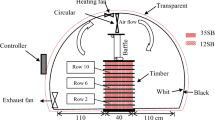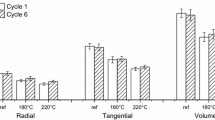Abstract
During drying, timber changes its shape mainly due to shrinkage anisotropy, radial differences in longitudinal shrinkage and spiral grain. The warp, causing severe downgrading of the timber, can be reduced by restraint and appropriate climate treatments of different types. The research presented here is part of a larger project on the improvement of shape stability of Norway Spruce (Picea abies) by high-temperature treatment. In this part, a method for determining twist as well as results for a drying temperature of 120 °C are presented. The effects of presteaming, drying and steaming with and without restraint on the size of twist in Norway Spruce were investigated in laboratory scale. Short-term twist-reducing effects as well as the permanency of the reduced distortions in subsequent moisture cycling were investigated. Results show a clear dependency of twist on the distance from the pith. Furthermore, the twist is reduced in restrained specimens sawn close to the pith. This effect is permanent even after exposure to subsequent moisture cycling.
Zusammenfassung
Während der Holztrocknung treten Formänderungen des Holzes hauptsächlich aufgrund der anisotropen Schwindung, der radial unterschiedlichen longitudinalen Schwindung und des Drehwuchses auf. Die zu grosser Deklassierung führenden Verformungen können durch Belastung während der Trocknung und geeignete Trocknungsprogramme vermindert werden. Die hier vorgestellte Forschungsarbeit ist Teil eines grösseren Projektes über die Verbesserung der Formbeständigkeit von Fichte (Picea abies) mit Hilfe von Hochtemperaturtrocknung. Es werden Methoden zur Bestimmung der Verdrehung und Ergebnisse für eine Trocknungstemperatur von 120 °C diskutiert. Die Wirkung von Dämpfen, Trocknung und Konditionierung mit und ohne äusserer Belastung auf die Verdrehung wurde an Fichte im Labormassstab untersucht. Sowohl die kurzfristige Verringerung der Verdrehung als auch die Beständigkeit dieser Verbesserung während Feuchtewechsel wurden untersucht. Die Ergebnisse zeigen eine deutliche Abhängigkeit der Verdrehung vom Abstand von der Markröhre. Die Verdrehung konnte in marknahen, eingespannten Proben verringert werden. Dieser Effekt bleibt auch nach mehreren Feuchtewechseln bestehen.
Similar content being viewed by others
References
Arganbright DG, Venturio JA, Gorvad M (1978) Warp Reduction in Young-Growth Ponderosa Pine Studs Dried by Different Methods with Top-Load Restraint. For Prod J 28(8):47–52
Haslett AN, Dakin M (2001) Effect of Pressure Steaming on Twist and Stability of Radiata Pine Lumber. Technical Note. For Prod J 51(2):85–88
Johansson M (2002) Moisture-induced distortion in Norway spruce timber – experiments and models. Doctoral thesis. Publ 02:3, Chalmers University of Technology, Sweden
Koch P (1974) Serrated Kiln Sticks and Top Load Substantially Reduce Warp in Southern Pine Studs Dried at 240 °F. For Prod J 24(11):30–35
McNaught AM, Gough DK (1995) Drying 40 mm Thick Slash Pine in 2.5 Hours at 200 °C. For Prod J 45(1):51–54
Mackay JFG (1973) The Influence of Drying Conditions and other Factors on Twist and Torque in Pinus Radiata Studs. Wood Fiber Sci 4(4):264–271
Mishiro A, Booker RE (1988) Warping in new crop Radiata pine 100×50 mm (2 by 4) boards. Bull Tokyo Univ For 80:37–68
Morén T (1994) Steam conditioning after low temperature drying. Holz Roh- Werkst 52:77–82
Morén T, Sehlstedt-Persson M (2001) Warp in timber: Drying of small-diameter logs of Norway Spruce (Formförändringar hos virke: Torkning av granreglar från klentimmer). Teknisk Rapport 2001:05, Luleå University of Technology, Institutionen i Skellefteå, Avdelningen för Träfysik (only in Swedish)
Perstorper M, Johansson M, Kliger R, Johansson G (2001) Distortion of Norway Spruce Timber. Part 1: Variation of Relevant Wood Properties. Holz Roh- Werkst 59:94–103
Price EW, Koch P (1980) Kiln Time and Temperature affect Shrinkage, Warp, and Mechanical Properties of Southern Pine Lumber. For Prod J 30(8):41–47
Salamon M (1969) High-temperature drying and its effect on wood properties. For Prod J 19(3):27–34
Simpson W (1982) Warp Reduction in Kiln-Drying Hardwood Dimension. For Prod J 32(5):29–32
Weckstein SA, Rice WW (1970) A System for Controlling Warp when Kiln-Drying Plantation-Grown Red Pine. For Prod J 20(9):70–74
Author information
Authors and Affiliations
Corresponding author
Rights and permissions
About this article
Cite this article
Frühwald, E. Improvement of shape stability by high-temperature treatment of Norway spruce Effects of drying at 120 °C with and without restraint on twist. Holz Roh Werkst 64, 24–29 (2006). https://doi.org/10.1007/s00107-005-0039-y
Published:
Issue Date:
DOI: https://doi.org/10.1007/s00107-005-0039-y




